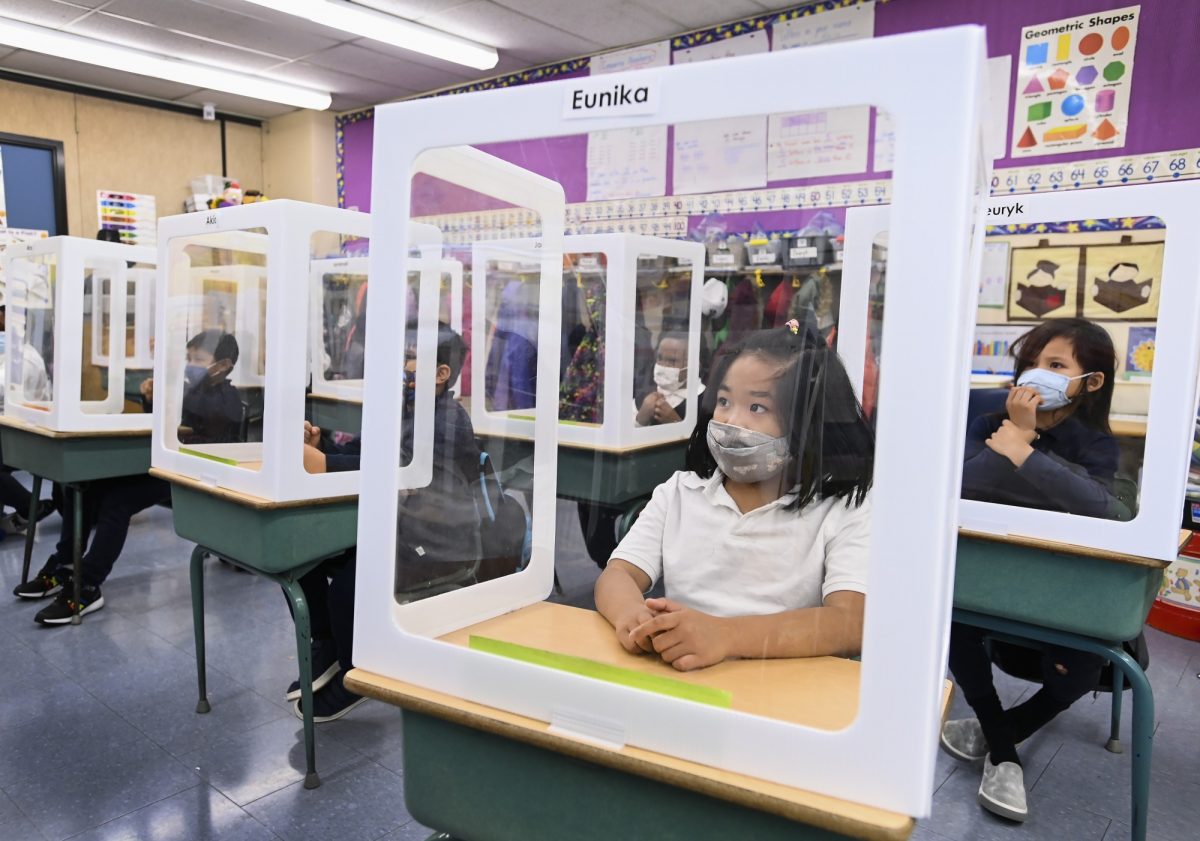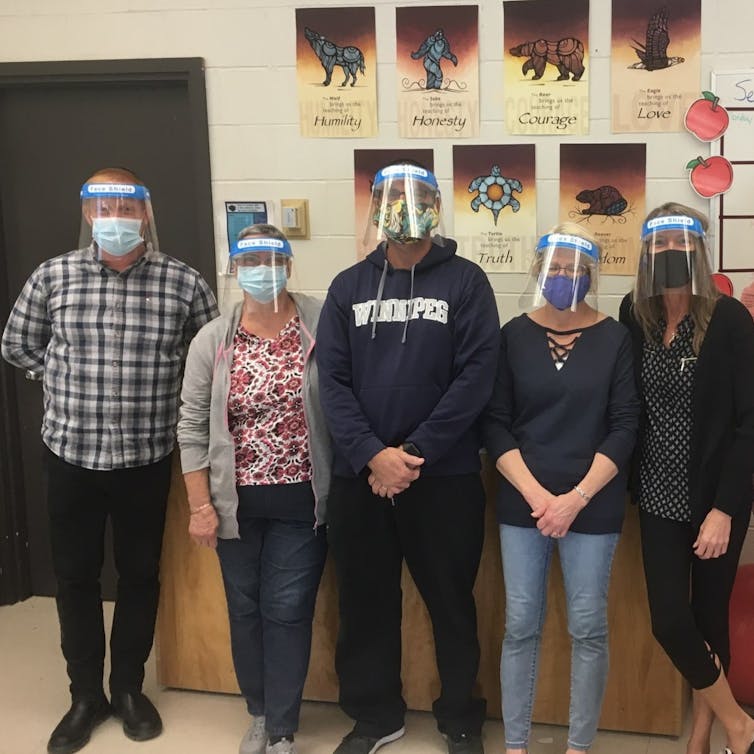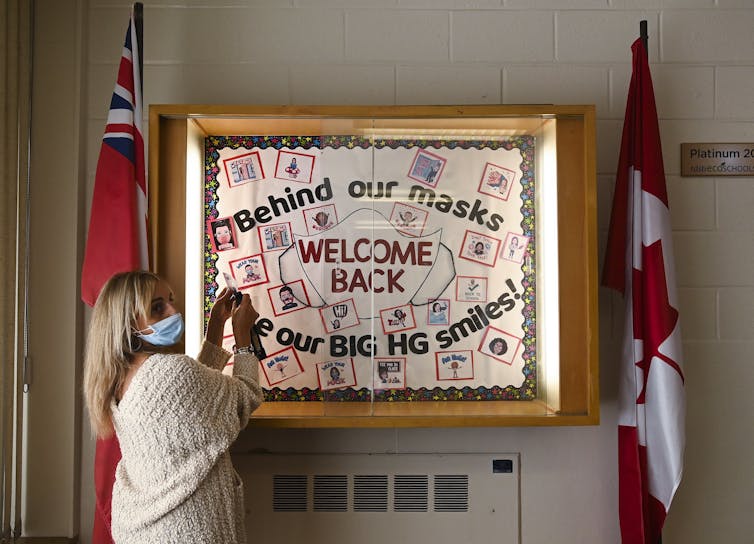
Remote learning doesn’t work for all children. Students sit behind screened-in cubicles at St. Barnabas Catholic School in Scarborough, Ont., on Oct. 27, 2020. THE CANADIAN PRESS/Nathan Denette
The Conversation: Students with disabilities should have the option of in-person learning during COVID-19 school closures
As communities cope with the second wave of COVID-19 across Canada, calls for front-line support pile up as provinces are in various stages of lockdown.
In many places across the country, teachers and families have a close eye on potential school closures in anticipation of another round of remote learning.
In Québec, the premier announced the province will extend the upcoming school holidays and temporarily move some students into virtual learning to accommodate holidays and a potential viral spike. In Manitoba, officials are considering extending holidays, while in Ontario the education minister says that’s not on the table for now.
Some parents in Manitoba have expressed confusion that schools are still open despite the fact that the entire province is under red-level restrictions.
Last spring, when schools closed due to COVID-19, many students with disabilities experienced a drastic lack of support and inappropriate educational programming. Across Canada and North America, there have been increasing reports of students with disabilities being left behind during this period of remote learning.
As we confront another wave of COVID-19 cases, schools should be making plans to continue safe in-person learning for students with disabilities for whom remote learning simply does not work.

Author Michael Baker, left, is a student service teacher at Springfield Collegiate Institute in Oakbank, Man., east of Winnipeg, who works primarily with students with disabilities and co-ordinates a team of four educational assistants who do the same. (Michael Baker), Author provided
Disability affects us all
In Canada, the 2017 Canadian Survey on Disability, conducted by Statistics Canada, reported one in five (22 per cent) Canadians aged 15 years and over — or about 6.2 million individuals — had one or more disabilities. Similarly, the Center for Disease Control (CDC) in the United States reports one in four (26 per cent) or about 61 million adults in the country have some type of disability.
These statistics convey a simple message: disability affects us all. The ubiquitous nature of disability should compel our society to move away from an “us versus them” mentality and toward an equitable and inclusive way of understanding.
Recognizing that remote learning may not work for everyone can allow school boards and schools to prepare safe accommodations, following health guidelines and protocols, which will allow all students to continue to receive an appropriate education in the least restricted environment.
Need for in-person learning
Amid COVID-19, every facet of society is being strained, mental health challenges are on the rise, economies are struggling, unemployment continues to soar and front-line workers and systems are under pressure.
Manitoba has procedural documents that outline the need to support and provide in-person learning and care for children of front-line workers who are school-aged. The province’s plans state that while in the province is in the red (critical) zone of the pandemic response system, kindergarten to Grade 12 schools “may be closed for in-class learning except for children of essential workers.”
Making such plans recognizes the need to support front-line workers and their families. The province should similarly recognize the needs of students with disabilities and their families as well.
British Columbia outlines the possibility of continued in-person learning for students with disabilities, advising: “If operationally feasible, school districts and independent school authorities should also consider offering priority care to parents/caregivers of students with unique needs (e.g. students with disabilities) and low-income parents with no other child-care options.”
Read more:
Coronavirus: Distance learning poses challenges for some families of children with disabilities
During the next round of lockdowns, and possible school closures, all provinces need to ensure students with disabilities receive the education they deserve. This hasn’t always been the case in Canada or the U.S.

A teacher places finishing touches on a welcome sign at Hunter’s Glen Junior Public School in Scarborough, Ont., in September 2020. (THE CANADIAN PRESS/Nathan Denette)
Better institutions
In her book A Special Hell: Institutional Life in Alberta’s Eugenic Years, sociologist Claudia Malacrida detailed how the institutionalization of people with disabilities in Alberta throughout the 20th century was characterized by confinement that was rarely voluntary. Similar conditions were seen throughout Canada, resulting in historical marginalization and oppression of people with disabilities across the country. Institutions were portrayed as “schools,” a place of care, which was rarely the case.
Albeit in a different social context, institutionalization of people with disabilities continues today.
Our mainstream educational institutions have become more inclusive of people with disabilities. Yet when our current educational systems treats the needs of children with disabilities as an afterthought and an exception, the legacy of marginalization lives on.
It is time education in Canada stops treating people with disabilities as second-class citizens.
In this together?
We have all heard countless times from our politicians, health officials and community members: “We are all in this together.” Students with disabilities deserve an education system that accords their learning needs, alongside every other student, as top priority.
As we prepare for another wave of COVID-19 cases, schools should be making plans to continue safe in-person learning for students with disabilities for whom remote learning does not work.
Let’s prove to ourselves that we can learn, adapt and do better. Let’s show our once-invisible students we are there for them, we care and we will not let them down.![]()
—
This article was written by Faculty of Education PhD student Michael Baker, and originally appeared in The Conversation. It is republished here under a Creative Commons license.
Research at the University of Manitoba is partially supported by funding from the Government of Canada Research Support Fund.






